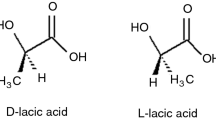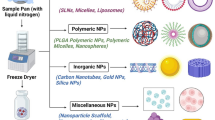Abstract
Five molecular weight grades of poly(DL-lactic acid) (PLA) were incorporated as organic and aqueous pseudolatex binders into matrix tablet formulations containing microcrystalline cellulose and the model drug theophylline. The tablets were thermally treated to temperatures above and below the glass transition temperature (T g) of the PLA. The results of the dissolution studies showed that thermally treating the tablets to temperatures above the T g of the PLA significantly retarded the matrix drug release compared to tablets which were not thermally treated. The retardation in drug release could be attributed to a stronger compact and a more efficient redistribution of polymer throughout the tablet matrix, based on fundamental principles of annealing. In addition, results from tablet index testing supported the dissolution results. The bonding index of the compact formulations increased after thermal treatment above the T g of the PLA. Gel permeation chromatography and differential scanning calorimetry studies demonstrated that thermal treatment had no significant effect on the molecular weight and the glass transition temperature of (PLA) alone and in combination with other components of the tablet formulation.
Similar content being viewed by others
REFERENCES
L. Nielson. Mechanical Properties of Polymers and Composites, Marcel Dekker, New York, 1974, pp. 139–229.
Encyclopedia of Polymer Science and Engineering, Vol. 2. Anionic Polymerization and Cationic Polymerization, John Wiley and Sons, New York, 1985, pp. 43–53.
S. Porter. The use of Opadry, Coateric and Surelease in the aqueous film coating of pharmaceutical oral dosage forms. In J. W. McGinity (ed.), Aqueous Polymeric Coatings for Pharmaceutical Dosage Forms, Marcel Dekker, New York, 1989, pp. 317–362.
M. R. Harris, I. Ghebre-Sellassie, and R. U. Nesbitt. A water-based coating process for sustained release. Pharm. Tech. 10(9):102–107 (1986).
T. Wheatly. Applications of Aquacoat ethylcellulose aqueous disperions for sustained release. In Y. Kaweshima (ed.), Recent Advances on Aqueous Polymeric Coating System and Related Techniques, Proceedings of the Pre World Congress, Particle Technology, Gifu, Japan, Sept. 1990, pp. 11–17.
B. H. Lippold, B. K. Sutter, and B. C. Lippold. Parameters controlling drug release from pellets coated with aqueous ethyl cellulose dispersions. Int. J. Pharm. 54:15–25 (1989).
I. Ghebre-Sellassie, U. Iyer, D. Kubert, and M. B. Fawzi. Characterization of a new water-based coating for modified-release preparations. Pharm. Tech. 12(9):96–106 (1988).
E. S. Ghali, G. H. Klinger, and J. B. Schwartz. Thermal treatment of beads with wax for controlled release. Drug Dev. Ind. Pharm. 15:1311–1328 (1989).
M. O. Omelczuk and J. W. McGinity. The influence of polymer glass transition temperature and molecular weight on the drug release from tablets containing poly(DL-lactic acid). Pharm. Res. 9:26–32 (1992).
M. O. Omelczuk. An Investigation of the Chemical, Physical-Mechanical, and Dissolution Properties of Controlled Release Tablets Containing Poly(d,l-lactic acid), Ph.D. dissertation, University of Texas at Austin, Austin, 1991.
M. Coffin and J. W. McGinity. Biodegradable pseudolatexes: The chemical stability of poly(DL-lactide) and poly(ecaprolactone) nanoparticles in aqueous media. Pharm Res. 9:200–205 (1992).
M. Coffin. The Development and Physical-Chemical Properties of Biodegradable Pseudolatexes and Their Application to Sustained Release Drug Delivery Systems, Ph.D. dissertation, University of Texas at Austin, Austin, 1990.
E. N. Hiestand, J. E. Wells, C. B. Poet, and J. F. Ochs. Physical process of tableting. J. Pharm. Sci. 66:510–519 (1977).
E. N. Hiestand and D. P. Smith. Indices of tableting performance. Powder Technol. 38:145 (1984).
E. N. Hiestand. The basis for practical applications of the tableting indices. Pharm. Tech. 13(9):54–66 (1989).
R. O. Williams III and J. W. McGinity. The use of tableting indices to study the compaction properties of powders. Drug Dev. Ind. Pharm. 14:1823–1844 (1988).
M. D. Schulze and J. W. McGinity. Physical-mechanical properties of spray-dried and milled acrylic resin polymers in combination with a brittle or plastic drug. S.T.P. Pharma Sci. 1:165–171 (1991).
R. O. Williams III and J. W. McGinity. Compaction properties of microcrystalline cellulose and sodium sulfathiazole in combination with talc or magnesium stearate. J. Pharm. Sci. 78:1025–1034 (1989).
U. W. Gedde. Thermal analysis of polymers. Drug Dev. Ind. Pharm. 16:2456–2465 (1990).
H. Mark and S. Atlas. Introduction to polymer science. In H. Kaufman and J. Falcetta (eds.), Introduction to Polymer Science and Technology, John Wiley and Sons, New York, 1977, pp. 1–23.
F. W. Billmeyer. The size and weight of polymer molecules. In H. Kaufman and J. Falcetta (eds.), Introduction to Polymer Science and Technology, John Wiley and Sons, New York, 1977, pp. 154–203.
F. W. Billmeyer. Measurement of molecular weight and size. In F. Billmeyer (ed.), Textbook of Polymer Science, Wiley Interscience, New York, 1984, pp. 186–219.
M. J. Richardson. Thermal analysis of polymers using quantitative differential scanning calorimetry. Polym. Test. 4:101–115 (1984).
F. Billmeyer. Analysis and testing of polymers. In H. Kaufman and J. Falcetta (eds.), Introduction to Polymer Science and Technology, John Wiley and Sons, New York, 1977, pp. 245–252.
T. Higuchi. Mechanism of sustained-action medication. J. Pharm. Sci. 52:1145 (1963).
M. C. Gupta and V. C. Deshmukh. Thermal oxididative degradation of poly-lactic acid. I. Activation energy of thermal degradation in air. Coll. Polym. Sci. 260:308–311 (1982).
C. Stuernagel. Latex emulsification for controlled drug delivery. In J. W. McGinity (ed.), Aqueous Polymeric Coatings for Pharmaceutical Dosage Forms, Marcel Dekker, New York, 1989, pp. 1–61.
Author information
Authors and Affiliations
Rights and permissions
About this article
Cite this article
Omelczuk, M.O., McGinity, J.W. The Influence of Thermal Treatment on the Physical-Mechanical and Dissolution Properties of Tablets Containing Poly(DL-Lactic Acid). Pharm Res 10, 542–548 (1993). https://doi.org/10.1023/A:1018993818206
Issue Date:
DOI: https://doi.org/10.1023/A:1018993818206




